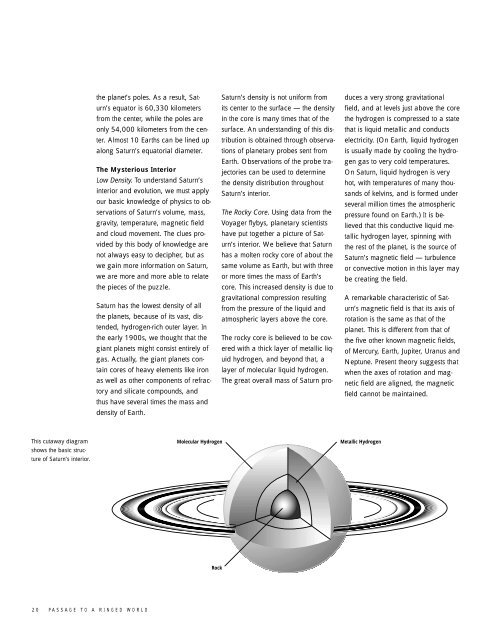Passage to a Ringed World - NASA's History Office
Passage to a Ringed World - NASA's History Office
Passage to a Ringed World - NASA's History Office
You also want an ePaper? Increase the reach of your titles
YUMPU automatically turns print PDFs into web optimized ePapers that Google loves.
This cutaway diagram<br />
shows the basic structure<br />
of Saturn’s interior.<br />
20 PASSAGE TO A RINGED WORLD<br />
the planet’s poles. As a result, Saturn’s<br />
equa<strong>to</strong>r is 60,330 kilometers<br />
from the center, while the poles are<br />
only 54,000 kilometers from the center.<br />
Almost 10 Earths can be lined up<br />
along Saturn’s equa<strong>to</strong>rial diameter.<br />
The Mysterious Interior<br />
Low Density. To understand Saturn’s<br />
interior and evolution, we must apply<br />
our basic knowledge of physics <strong>to</strong> observations<br />
of Saturn’s volume, mass,<br />
gravity, temperature, magnetic field<br />
and cloud movement. The clues provided<br />
by this body of knowledge are<br />
not always easy <strong>to</strong> decipher, but as<br />
we gain more information on Saturn,<br />
we are more and more able <strong>to</strong> relate<br />
the pieces of the puzzle.<br />
Saturn has the lowest density of all<br />
the planets, because of its vast, distended,<br />
hydrogen-rich outer layer. In<br />
the early 1900s, we thought that the<br />
giant planets might consist entirely of<br />
gas. Actually, the giant planets contain<br />
cores of heavy elements like iron<br />
as well as other components of refrac<strong>to</strong>ry<br />
and silicate compounds, and<br />
thus have several times the mass and<br />
density of Earth.<br />
Molecular Hydrogen<br />
Rock<br />
Saturn’s density is not uniform from<br />
its center <strong>to</strong> the surface — the density<br />
in the core is many times that of the<br />
surface. An understanding of this distribution<br />
is obtained through observations<br />
of planetary probes sent from<br />
Earth. Observations of the probe trajec<strong>to</strong>ries<br />
can be used <strong>to</strong> determine<br />
the density distribution throughout<br />
Saturn’s interior.<br />
The Rocky Core. Using data from the<br />
Voyager flybys, planetary scientists<br />
have put <strong>to</strong>gether a picture of Saturn’s<br />
interior. We believe that Saturn<br />
has a molten rocky core of about the<br />
same volume as Earth, but with three<br />
or more times the mass of Earth’s<br />
core. This increased density is due <strong>to</strong><br />
gravitational compression resulting<br />
from the pressure of the liquid and<br />
atmospheric layers above the core.<br />
The rocky core is believed <strong>to</strong> be covered<br />
with a thick layer of metallic liquid<br />
hydrogen, and beyond that, a<br />
layer of molecular liquid hydrogen.<br />
The great overall mass of Saturn pro-<br />
duces a very strong gravitational<br />
field, and at levels just above the core<br />
the hydrogen is compressed <strong>to</strong> a state<br />
that is liquid metallic and conducts<br />
electricity. (On Earth, liquid hydrogen<br />
is usually made by cooling the hydrogen<br />
gas <strong>to</strong> very cold temperatures.<br />
On Saturn, liquid hydrogen is very<br />
hot, with temperatures of many thousands<br />
of kelvins, and is formed under<br />
several million times the atmospheric<br />
pressure found on Earth.) It is believed<br />
that this conductive liquid metallic<br />
hydrogen layer, spinning with<br />
the rest of the planet, is the source of<br />
Saturn’s magnetic field — turbulence<br />
or convective motion in this layer may<br />
be creating the field.<br />
A remarkable characteristic of Saturn’s<br />
magnetic field is that its axis of<br />
rotation is the same as that of the<br />
planet. This is different from that of<br />
the five other known magnetic fields,<br />
of Mercury, Earth, Jupiter, Uranus and<br />
Neptune. Present theory suggests that<br />
when the axes of rotation and magnetic<br />
field are aligned, the magnetic<br />
field cannot be maintained.<br />
Metallic Hydrogen
















